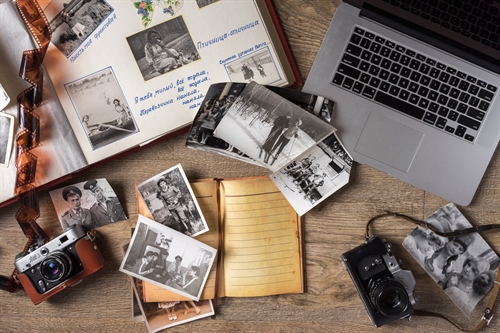Digital images are very convenient, but for sheer hold-in-your-hands impact, nothing beats a crisp, clear print. Also, many family snaps from previous generations are in print form. But historic prints are delicate, and the older they are, the more likely it is that they have suffered atmospheric damage.
First, declutter your prints
You may be able to make a collection of prints more manageable by culling failed and duplicate images. But how do you dispose of old photos responsibly?
Note that photos, negative and transparencies can’t go in the recycling bin. The images on photographs are made by coating paper with a cocktail of chemicals. Your local council will not want you to put old photographs in the recycling bin. So unwanted prints and polaroids are best placed in general waste. But if you have a very large number of photographic prints that you need to dispose of, it may be time to speak with a professional waste service.
Before you bin unwanted photo prints and slides, it’s worth checking quickly with your family in case anyone wants them. Some types of images, for example aviation or local history, might be welcomed by a special interest group. And there is a ready market for photographic memorabilia on Etsy for old prints and transparencies.
Albums are better than boxes
You’ll want an archive-safe storage system for your collection of prints. If you can, mount your pictures in photo albums. Look for inert, acid-free albums for long-term safe storage of family photographic prints. The mounts of old photos may have information on them, such as names and dates, or even the address of the photographer, so think twice before you separate them from the photo.
Temperature controlled storage
A temperature- and humidity-controlled environment is the best gift you can give to your family photos. Rapid rises and falls in temperature and atmospheric moisture can speed up the deterioration of prints, so a climate-controlled storage space will keep them in the best condition for the next generation.
How much does it cost to store photographs outside the home?
Are you hesitating to spend out on storing your family’s history? The monthly cost of storage outside your home doesn’t have to be a burden. The standard advice for any service is to shop around, but it can be tricky to compare different storage offerings and to find out how much it will actually be to rent a storage unit. We’ve got a self-storage costing guide that will help you to get the information you need to shop around for storage outside the home. Also, did you know that you can often save money on self-storage insurance by shopping around. Get a quick self-storage insurance quote from us today to start you off.
Is it worth digitising your photographic prints?
Scanning family photos means you can share them more easily, upload them to genealogy sites and it is a good back-up, too.
There are commercial scanning services available, or you can do it yourself. However, this can be a time-consuming project. And remember that the prints themselves may have intrinsic value, too. There is nothing quite like handling a physical object to make you feel close to your ancestors.
Your photographic memories are safe in storage
Once you’ve got your family photos organised and safely stored, you’ll have peace of mind, and you’ll be able to access the information in your family archive quickly and easily.



